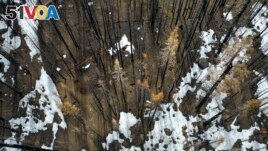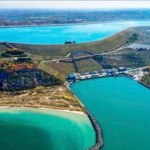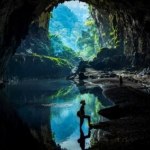28 April 2022
Climate change is fueling the spread of wildfires across the Western United States, scientists say.
Researchers want to know how the fires might affect water supplies in the area. Communities often depend on melting snow in the spring as their water supply during dryer months.
Studies show that snow in a burned forest melts up to several weeks earlier than snow in a healthy forest. The burned trees no longer provide much shade and release small amounts of carbon. These conditions mean the snow absorbs, or takes in, more sunlight. This makes it melt faster, said Anne Nolin. She researches how burned trees from forest fires affects snowmelt for the University of Nevada.

Burned trees stand near patches of melting snow at the site of the 2021 Caldor Fire, Monday, April 4, 2022, near Twin Bridges, Calif.
If snow melts earlier than normal, Nolin said, that would likely leave less water flowing in the summer when it is most needed.
Water predictions look at conditions like snow density, soil wetness and air temperature. Dust, ash and soot similarly affect snow by causing it to absorb more light. That is called the "albedo effect." But California officials are increasingly worried about carbon, which absorbs even more.
"It was like, OK, we really need to understand this. This is the new norm," said David Rizzardo. He is with the California Department of Water Resources.
In some fire-damaged areas, state officials are beginning to create maps of snow. They use planes with cameras that can measure albedo.
Already, a warming climate is leading to earlier snowmelt and leaving places more likely to have wildfires, said Noah Molotch. He researches water and snow at the University of Colorado. A burned area worsens the effects of drought by leading to even dryer conditions in hotter months, he said.
Nolin and student Arielle Koshkin worked in California's El Dorado National Forest for one of their final research trips in early April. That is when the area usually has the most snow. But little remained when they arrived, in part because of unusually hot temperatures this spring and many days without clouds.
Late-season storms have since covered the area with several centimeters of new snow. This, Nolin said, could help slow the melt.
The Caldor Fire that burned the area and more than 80,000 hectares last year has left nearby communities worried over water supply.
About 65 kilometers southwest from where Nolin measured the snow sits the town of Grizzly Flats. The town is working to fix a water pipeline damaged in the fire. The pipeline sends snowmelt into a reservoir, or manmade lake. Burned trees, however, keep falling and damaging the pipeline.
It is not yet clear exactly how the burned trees might affect the town's water supply in the future. So far this year, water managers said runoff from snowmelt appears normal. But officials do not know for sure because measuring devices were destroyed in the fire.
Jodi Lauther is the general manager of the local water agency. She is concerned about the fire's lasting effects. For now, she said, "we are in survival mode."
I'm Dan Novak.
Dan Novak adapted this story for VOA Learning English based on reporting from The Associated Press.
_____
Words in This Story
shade — n. an area of slight darkness that is produced when something blocks the light of the sun
density — n. the amount of something in a particular space or area
soot — n. a black powder that is formed when something is burned
drought — n. a long period of time during which there is very little or no rain
manager — n. someone who is in charge of a business, department, etc.
mode — n. a specified way of thinking, feeling, or acting










